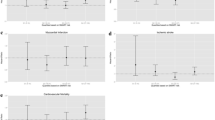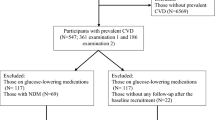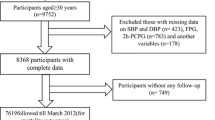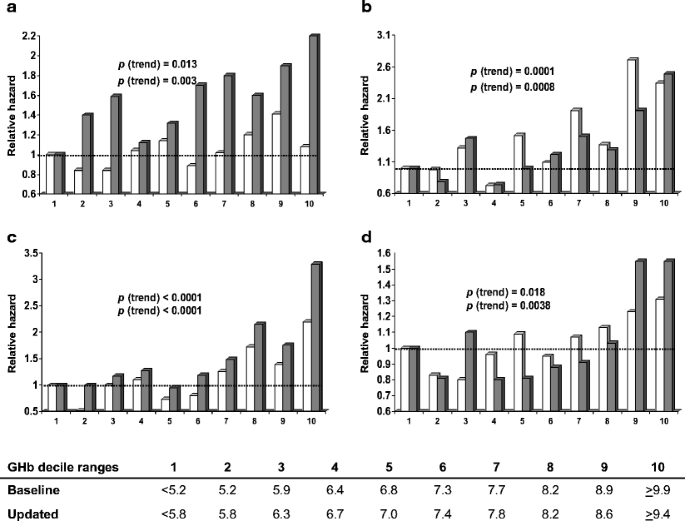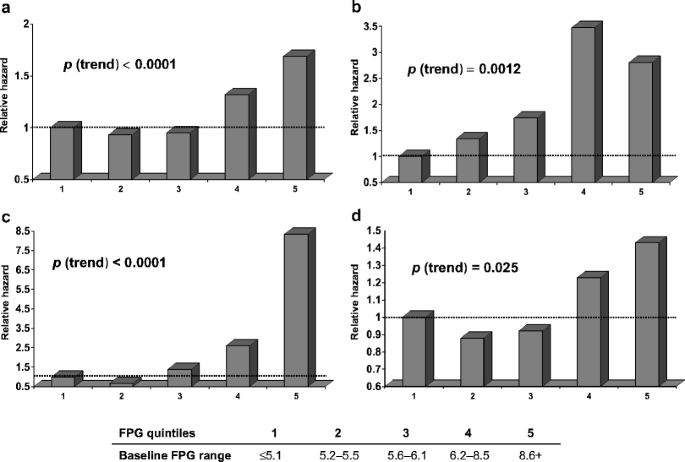Abstract
Aims/hypothesis
Emerging data suggest that different indices of glycaemia are risk factors for clinical events. The aim of this analysis was to investigate the relationship between fasting plasma glucose or glycated haemoglobin (GHb) levels and incident cardiovascular (CV) outcomes, death, heart failure and overt nephropathy in diabetic and non-diabetic individuals enrolled in the Heart Outcomes Prevention Evaluation (HOPE) study.
Materials and methods
The adjusted 4.5-year risk of CV events (myocardial infarction or stroke or CV death), heart failure, death and overt nephropathy was analysed in relation to baseline and updated GHb levels (in 3,529 diabetic HOPE study participants) and baseline fasting plasma glucose levels (in 1,937 non-diabetic and 1,013 diabetic participants).
Results
In diabetic participants, a 1% absolute rise in the updated GHb predicted future CV events (relative risk [RR]=1.07, 95% CI 1.01–1.13; p=0.014), death (RR=1.12, 95% CI 1.05–1.19; p=0.0004), heart failure (RR=1.20, 95% CI 1.08–1.33; p=0.0008) and overt nephropathy (RR=1.26, 95% CI 1.17–1.36; p<0.0001) after adjusting for age, sex, diabetes duration, blood pressure, WHR, hyperlipidaemia and ramipril. Similarly, a 1 mmol/l rise in fasting plasma glucose was related to an increased risk of CV outcomes (RR=1.09, 95% CI 1.05–1.13; p<0.0001), death (RR=1.06, 95% CI 1.01–1.12; p=0.017), heart failure (RR=1.16, 95% CI 1.06–1.13; p=0.0007) and overt nephropathy (RR=1.34, 95% CI 1.23–1.45; p<0.0001) in the group composed of diabetic and non-diabetic individuals. The significant relationship between fasting plasma glucose and CV outcomes persisted after adjustment for diabetes status (RR=1.06, 95% CI 1.00–1.12; p=0.043).
Conclusions/interpretation
There is an independent progressive relationship between indices of glycaemia and incident CV events, renal disease and death. Clinical trials of glucose lowering to prevent these outcomes in diabetic and non-diabetic individuals are indicated.
Similar content being viewed by others
Introduction
Diabetes mellitus is universally recognised as a strong, independent risk factor for cardiovascular (CV) events [1]. Compared with non-diabetic individuals, those with diabetes are two to three times more likely to have a CV event; moreover, the proportion of people with diabetes who will die from cardiovascular causes is >70% [2]. Epidemiological and mechanistic explanations that have been proposed to account for this strong relationship include: (1) prolonged exposure to hyperglycaemia and its consequences [3]; (2) antecedent and concurrent insulin resistance [4, 5]; (3) effective insulin deficiency [6]; (4) associated lipid and blood pressure abnormalities [7]; and (5) an as yet undefined determinant of both diabetes and CV disease. Varying proportions of individuals with diabetes manifest one or more of these abnormalities; however, as diabetes is defined on the basis of an elevated glucose level, everyone with diabetes has a history of hyperglycaemia. This has focused attention on the role of the plasma glucose level as a potential risk factor for CV events and atherosclerosis in both diabetic and non-diabetic individuals [8–10].
A growing body of epidemiological evidence now supports the possibility that the degree of dysglycaemia, as measured by either the glucose level or the HbA1c level, is an independent risk factor for CV events [11]. Moreover, this relationship has been observed in people with and without evidence of diabetes [8, 9, 12]. What remains unclear is the degree to which the CV risk attributable to diabetes is explained by the elevated glucose level [13]. It is also unknown whether the glucose–CV risk relationship can be accounted for by a link between glucose and other CV risk factors such as hypertension, hyperlipidaemia and abdominal obesity.
The Heart Outcomes Prevention Evaluation (HOPE) study was an international 4.5-year multicentre trial that showed that the ACE inhibitor ramipril reduced the risk of CV events in a broad spectrum of diabetic and non-diabetic high-risk participants [14]. Individuals with diabetes were required to have a locally measured glycated haemoglobin (GHb) level at baseline and annually throughout the study. In addition, a baseline fasting serum sample was collected in 3,196 diabetic and non-diabetic individuals who were enrolled within Canada. These data provide an opportunity to assess the epidemiological relationship between GHb, fasting plasma glucose and CV outcomes in individuals with and without diabetes.
Subjects and methods
Participants
The HOPE study randomly allocated people at high risk of cardiovascular events to receive 10 mg of ramipril or placebo daily, and/or 400 IU of vitamin E or placebo daily using a factorial design. A total of 9,541 people (3,577 with self-reported diabetes at baseline) were recruited within 19 countries and were followed every 6 months for a median of 4.5 years for the development of study outcomes. The HOPE study was approved at each centre by the local ethics committee and all participants provided written informed consent.
GHb was measured in all participants with self-reported diabetes (in each study centre’s local laboratory) as either total GHb or HbA1c. The results of baseline and annual measurements were recorded throughout the study as an assessment of diabetes control. Investigators were not asked to measure or record GHb levels in participants without a history of diabetes. Fasting venous blood samples from the diabetic and non-diabetic participants who were recruited in Canadian sites were collected at baseline, frozen, and then stored centrally in liquid nitrogen for subsequent analyses. This report focuses on the relationship of GHb (in all participants with diabetes) and fasting plasma glucose (in the Canadian diabetic and non-diabetic participants) with the incident key study outcomes.
Assessment of glycaemia and other risk factors
Both the measured GHb result and the upper limit of normal for the assay used were recorded whenever GHb was measured. The GHb results were then expressed and analysed as a ‘derived HbA1c’ based on an assay with an upper limit of normal of 6.0%, which was calculated as: (local measured result/local upper limit)×6%. Fasting plasma glucose was measured on stored plasma in the central laboratory using a glucose oxidase method (Integra; Roche Diagnostics, Basel, Switzerland), and total cholesterol and HDL cholesterol were measured on centrally stored plasma using an enzymatic, colorimetric method (Integra; Roche Diagnostics). Albuminuria was measured in four central laboratories around the world, as previously reported [15, 16]. Participants were deemed to have a history of hyperlipidaemia if a recent total cholesterol was >5.2 mmol/l, a recent HDL cholesterol was <0.9 mmol/l, or if they were taking lipid-lowering medication.
Outcomes analysed
The definitions of the key outcomes measured in the HOPE study and Microalbuminuria, Cardiovascular, and Renal Outcomes in HOPE (MICRO-HOPE) substudy have been published previously in detail [14, 17]. Briefly, the primary outcome was the first occurrence of one or more of the following: non-fatal myocardial infarction, stroke or CV death. Key secondary outcomes included total mortality, hospitalisation for congestive heart failure, overt nephropathy (i.e. measured as clinical proteinuria) and each component of the composite primary outcome. Participants were assessed for the development of overt nephropathy at baseline and study end; diabetic participants were also assessed for this outcome at 1 year. Overt nephropathy was defined as a urinary AER ≥ 300 mg/day or 200 μg/min; a urinary protein excretion rate ≥500 mg/day; or (in the absence of a timed collection) a first morning urine albumin : creatinine ratio >36 mg/mmol.
Statistical analyses
Two groups of participants were analysed: (1) all diabetic participants with GHb measurements; and (2) diabetic and non-diabetic participants for whom fasting baseline blood was stored (i.e. those who were enrolled in Canada) and later assayed for plasma glucose (GHb levels were not measured in the non-diabetic participants).
During the course of the trial, updated GHb levels were calculated for each diabetic individual as the mean of all of the available measurements for that individual during the entire period of follow-up. Any individual for whom there was one or more GHb value was included in this analysis, regardless of the number of available GHb levels that contributed to the updated number.
The relationship between GHb and the risk of outcomes in diabetic participants was analysed by relating the incidence of an event to two different assessments of GHb: the baseline level and the updated level. GHb was assessed as a categorical variable (i.e. according to each decile of the distribution) and as a continuous variable. Cox regression models were used to estimate the covariate-adjusted relative hazard for each event within each decile of GHb and for a 1% rise in GHb. The relationship between baseline fasting plasma glucose (according to each quintile of glucose and as a continuous variable) and the risk of outcomes in diabetic and non-diabetic participants was analysed using a similar approach. A p value of less than 0.05 was considered significant.
Results
A locally measured baseline GHb level was available for 3,529 (98.7%) of the 3,577 participants with a history of diabetes, and a centrally measured fasting plasma glucose level was available for 2,950 (92.3%) of the 3,196 non-diabetic (n=1,937) and diabetic (n=1,013) participants for whom a baseline serum sample was stored. Baseline biochemical and clinical data for each of these two groups are listed in Table 1.
GHb and incident CV and renal outcomes in diabetes
There was a consistent and progressive relationship between the GHb level (both baseline and updated) and the age- and sex-adjusted relative hazard of the following outcomes: (1) the primary outcome; (2) hospitalisation for congestive heart failure; (3) total mortality; and (4) overt nephropathy (Fig. 1). The strongest relationships were seen with the updated GHb level. After adjusting for age, sex, diabetes duration, systolic and diastolic blood pressure, WHR, history of hyperlipidaemia, and randomisation to ramipril, a 1% rise in the updated GHb level was associated with a 7% rise in the risk of the primary outcome, a 20% rise in the risk of hospitalisation for heart failure, a 12% rise in the risk of total mortality, and a 26% rise in the risk of overt nephropathy (Table 2).
The progressive relationship between baseline (white bars) and updated (shaded bars) GHb levels (divided into deciles) and the age- and sex-adjusted relative hazard of the primary outcome (a), hospitalisation for heart failure (b), overt nephropathy (c) and total mortality (d). The lower limits of the ranges for each decile are indicated below the figure.
Fasting plasma glucose and incident CVD and renal outcomes
A similar relationship was seen between baseline fasting plasma glucose and the age- and sex-adjusted risk of each of the outcomes (Fig. 2). Moreover, after adjusting for age, sex, systolic and diastolic blood pressure, WHR, history of hyperlipidaemia, and allocation to ramipril, a 0.15-unit rise in baseline log fasting plasma glucose (equivalent to an increment in fasting plasma glucose of approximately 1 mmol/l) was associated with a 9% rise in the risk of the primary outcome, a 16% rise in the risk of hospitalisation for heart failure, a 6% rise in the risk of total mortality and a 34% rise in the risk of overt nephropathy (Table 3). Similar results were noted when hyperlipidaemia was replaced in the model by the fasting cholesterol:HDL cholesterol ratio and the triglyceride level (Table 3). The significant relationship between fasting plasma glucose and the primary outcome (but not the other outcomes) was retained after adjustment for the presence of diabetes (relative risk [RR]=1.06; 95% CI 1.00–1.12; p=0.043).
Discussion
In this epidemiological analysis of the HOPE study data collected in individuals with diabetes, the GHb value was an independent risk factor for a broad range of outcomes, including CV events, heart failure, death and overt nephropathy. A very similar relationship between fasting plasma glucose and outcomes was also noted in the group that included both diabetic and non-diabetic individuals. In this latter group, the relationship between fasting plasma glucose and CV events was maintained even after accounting for the presence or absence of diabetes.
The progressive nature of the relationship between the indices of glycaemia (GHb and fasting plasma glucose) and outcomes, and the observation that fasting plasma glucose is a risk factor for CV events even after statistically accounting for the presence of diabetes, support the conclusion that it is the degree of hyperglycaemia, rather than the presence or absence of diabetes as such, that is related to future CV outcomes. As the relationship between outcomes and the indices of glycaemia was not attenuated after adjusting for blood pressure, abdominal obesity or hyperlipidaemia, these other risk factors are insufficient to explain all of the risk associated with dysglycaemia. Of note, however, it is possible that the relationship would have been attenuated to some degree if the definition of hyperlipidaemia had included hypertriglyceridaemia. The fact that this was not observed with respect to the relationship between fasting plasma glucose and events argues against this possibility. Thus, these analyses support the hypothesis that management of traditional risk factors may not eliminate the risk related to glucose. Similarly, accounting for randomisation to ramipril did not attenuate the relationship of clinical outcomes with either GHb or fasting plasma glucose. Thus, the proven CV and renal benefits of ramipril [14, 16, 18] cannot be completely explained by its possible effect on glucose levels.
These data are limited by the fact that GHb levels were not assessed centrally or by the same methodology, and may not all have been determined using assays standardised to international reference assays. They are also limited by the fact that GHb levels were only measured in diabetic participants. Thus, these data do not provide information regarding the relationship between GHb and outcomes in non-diabetic individuals. Moreover, glucose tolerance tests were not performed in participants to definitively determine their diabetes status or degree of hyperglycaemia, and fasting plasma glucose was only measured in a subset of diabetic individuals. Clearly, these additional data, as well as data on other CV risk factors, would have added precision and confidence to the risk estimates in both diabetic and non-diabetic individuals, and would have enabled an analysis of the relative importance of the GHb level, as compared with the glucose level, as a predictor of events. Nevertheless, the fact that strong associations were seen despite this heterogeneity and possibility of misclassification suggests that these findings are robust. Indeed, the observation of a stronger link between outcomes and updated GHb (compared with the baseline GHb) is consistent with the well-known phenomenon of regression–dilution bias [19] and suggests that a stronger association between fasting plasma glucose and outcomes would have been detected if updated fasting plasma glucose levels were available. Thus, it is likely that these findings are underestimates of the true relationship between indices of glycaemia and key clinical outcomes.
These prospective observations from the HOPE study add to a growing body of epidemiological data in both diabetic and non-diabetic individuals [11, 12, 20–23], and further support the possibility that glucose lowering may reduce CV events. They also strongly support the need for large randomised, controlled clinical trials designed to confirm or refute preliminary suggestions that glucose lowering may reduce CV events in ambulatory people with newly diagnosed diabetes [24], established diabetes [25] or IGT [26, 27].
Abbreviations
- CV:
-
cardiovascular
- GHb:
-
glycated haemoglobin
- HOPE:
-
Heart Outcomes Prevention Evaluation
- RR:
-
relative risk
References
Gerstein HC, Malmberg K, Capes S, Yusuf S (2001) Cardiovascular diseases. In: Gerstein HC, Haynes RB (eds) Evidence-based diabetes care. BC Decker, Hamilton, pp 488–514
Laakso M (1999) Hyperglycemia and cardiovascular disease in type 2 diabetes. Diabetes 48:937–942
Brownlee M (2001) Biochemistry and molecular cell biology of diabetic complications. Nature 414:813–820
Bonora E, Formentini G, Calcaterra F et al (2002) HOMA-estimated insulin resistance is an independent predictor of cardiovascular disease in type 2 diabetic subjects: prospective data from the Verona Diabetes Complications Study. Diabetes Care 25:1135–1141
Baron AD (2002) Insulin resistance and vascular function. J Diabetes Its Complicat 16:92–102
Porte D Jr, Kahn SE (2001) Beta-cell dysfunction and failure in type 2 diabetes: potential mechanisms. Diabetes 50(Suppl 1):S160–S163
Lakka HM, Laaksonen DE, Lakka TA et al (2002) The metabolic syndrome and total and cardiovascular disease mortality in middle-aged men. JAMA 288:2709–2716
DECODE Study Group, European Diabetes Epidemiology Group (2003) Is the current definition for diabetes relevant to mortality risk from all causes and cardiovascular and noncardiovascular diseases? Diabetes Care 26:688–696
Coutinho M, Gerstein HC, Wang Y, Yusuf S (1999) The relationship between glucose and incident cardiovascular events. A metaregression analysis of published data from 20 studies of 95,783 individuals followed for 12.4 years. Diabetes Care 22:233–240
Gerstein HC, Anand S, Yi QL et al (2003) The relationship between dysglycemia and atherosclerosis in South Asian, Chinese, and European individuals in Canada: a randomly sampled cross-sectional study. Diabetes Care 26:144–149
Stratton IM, Adler AI, Neil HA et al (2000) Association of glycaemia with macrovascular and microvascular complications of type 2 diabetes (UKPDS 35): prospective observational study. BMJ 321:405–412
Khaw KT, Wareham N, Luben R et al (2001) Glycated haemoglobin, diabetes, and mortality in men in Norfolk cohort of European Prospective Investigation of Cancer and Nutrition (EPIC-Norfolk). BMJ 322:15–18
Heine RJ, Dekker JM (2002) Beyond postprandial hyperglycaemia: metabolic factors associated with cardiovascular disease. Diabetologia 45:461–475
HOPE Study Investigators (2000) Effects of an angiotensin-converting-enzyme inhibitor, ramipril, on cardiovascular events in high-risk patients. N Engl J Med 342:145–153
Gerstein HC, Bosch J, Pogue J et al (1996) Rationale and design of a large study to evaluate the renal and cardiovascular effects of an ACE inhibitor and vitamin E in high-risk patients with diabetes. The MICRO-HOPE study. Diabetes Care 19:1225–1228
Heart Outcome Prevention Evaluation (HOPE) Study Investigators (2000) Effects of ramipril on cardiovascular and microvascular outcomes in people with diabetes mellitus: results of the HOPE study and MICRO-HOPE substudy. Lancet 355:253–259
HOPE Study Investigators (1996) The HOPE (Heart Outcomes Prevention Evaluations) Study: the design of a large, simple randomized trial of an angiotensin converting enzyme inhibitor (ramipril) and vitamin E in patients at high risk of cardiovascular events. Can J Cardiol 12:127–137
Mann JF, Gerstein HC, Yi QL et al (2003) Development of renal disease in people at high cardiovascular risk: results of the HOPE randomized study. J Am Soc Nephrol 14:641–647
Clarke R, Shipley M, Lewington S et al (1999) Underestimation of risk associations due to regression dilution in long-term follow-up of prospective studies. Am J Epidemiol 150:341–353
Selvin E, Marinopoulos S, Berkenblit G et al (2004) Meta-analysis: glycosylated hemoglobin and cardiovascular disease in diabetes mellitus. Ann Intern Med 141:421–431
Gerstein HC, Capes SE (2002) Dysglycemia: a key cardiovascular risk factor. Semin Vasc Med 2:165–174
Khaw KT, Wareham N, Bingham S, Luben R, Welch A, Day N (2004) Association of hemoglobin A1c with cardiovascular disease and mortality in adults: the European prospective investigation into cancer in Norfolk. Ann Intern Med 141:413–420
Gerstein HC (2004) Glycosylated hemoglobin: finally ready for prime time as a cardiovascular risk factor. Ann Intern Med 141:475–476
UK Prospective Diabetes Study (UKPDS) Group (1998) Intensive blood-glucose control with sulphonylureas or insulin compared with conventional treatment and risk of complications in patients with type 2 diabetes (UKPDS 33). Lancet 352:837–853
Ohkubo Y, Kishikawa H, Araki E et al (1995) Intensive insulin therapy prevents the progression of diabetic microvascular complications in Japanese patients with non-insulin-dependent diabetes mellitus: a randomized prospective 6-year study. Diab Res Clin Pract 28:103–117
Chiasson JL, Josse RG, Gomis R, Hanefeld M, Karasik A, Laakso M (2003) Acarbose treatment and the risk of cardiovascular disease and hypertension in patients with impaired glucose tolerance: the STOP-NIDDM trial. JAMA 290:486–494
Knowler WC, Sartor G, Melander A, Schersten B (1997) Glucose tolerance and mortality, including a substudy of tolbutamide treatment. Diabetologia 40:680–686
Acknowledgements
This work was funded by grants from the Medical Research Council of Canada (Grant numbers MT12790 and UI12362), Aventis, Astra Zeneca, the Natural Source Vitamin E Association, NEGMA and King Pharmaceuticals.
Duality of Interest
H. C. Gerstein has received consulting fees, speaker’s fees and grants from the following companies with drugs that lower glucose levels: Aventis, Novo Nordisk, Eli Lilly and GSK. G. R. Dagenais has received speaker’s fees from Aventis.
Author information
Authors and Affiliations
Consortia
Corresponding author
Additional information
Listed by country in References 13 and 15.
Rights and permissions
About this article
Cite this article
Gerstein, H.C., Pogue, J., Mann, J.F.E. et al. The relationship between dysglycaemia and cardiovascular and renal risk in diabetic and non-diabetic participants in the HOPE study: a prospective epidemiological analysis. Diabetologia 48, 1749–1755 (2005). https://doi.org/10.1007/s00125-005-1858-4
Received:
Accepted:
Published:
Issue Date:
DOI: https://doi.org/10.1007/s00125-005-1858-4


